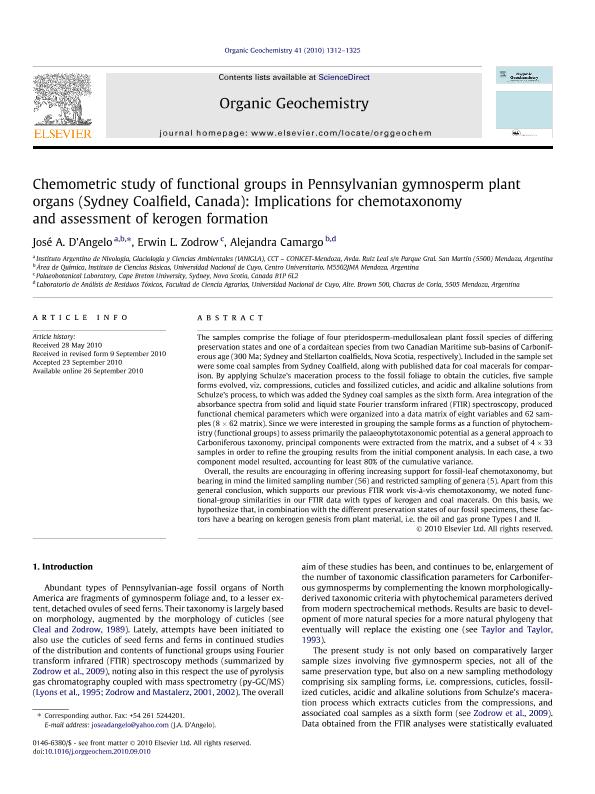Artículo
Chemometric study of functional groups in Pennsylvanian gymnosperm-plant organs (Sydney Coalfield, Canada): Implications for chemotaxonomy and assessment of kerogen formation
Fecha de publicación:
09/2010
Editorial:
Pergamon-Elsevier Science Ltd
Revista:
Organic Geochemistry
ISSN:
0146-6380
Idioma:
Inglés
Tipo de recurso:
Artículo publicado
Clasificación temática:
Resumen
The sample specimens for study comprise the foliage of four pteridosperm-medullosalean plant-fossil species of differing preservation states and one of a cordaitean species from two CanadianMaritime Sub-Basins of Carboniferous age, 300 Ma, i.e., Sydney and Stellarton coalfields in Nova Scotia, respectively. Included in the sample are some coal samples from Sydney Coalfield, and published data of coal macerals for comparisons. By applying Schulze´s aceration process to the fossil foliage to obtain the cuticles, five sample forms evolved, viz. compressions, cuticles, fossilized cuticles, and acidic and alkaline solutions from Schulze´s process to which is added Sydney´s coal samples as form 6. Area integration under the absorbance curve of spectra from solid and liquid state Fourier ansform infrared (FTIR) spectroscopy, produced functional chemical parameters which were organized into a data matrix of eight variables and 62 samples (8x62 matrix). Since we are interested in groupings ofthe sample forms as a function of phytochemistry (functional groups) to assess primarily the palaeophytotaxonomic potential as a general approach to Carboniferous taxonomy, principal components were extracted from that matrix, then using a subset of 4x33 samples in order to refine the grouping results of the initial component analysis. In either case, a two-component model resulted, accounting for least 80% of cumulative variance in either case. Presented are results of the various analyses, which overall, are encouraging in offering increasingsupport for fossil-leaf chemotaxonomy, realizing at the same time our limited sampling number (56) and small sampling of genera (5). Apart from this general conclusion, which supports our previous FTIR work vis-à-vis chemotaxonomy, we noted functional-group similarities in our FTIR data with types of kerogen and coal macerals. On this basis, we hypothesize that in combination with the different preservation states of our fossil specimens these factors have a bearing on kerogen genesis from plant material, i.e., the oil and gas prone Types I and II.
Palabras clave:
Carboniferous
,
Compression-cuticles
,
Schulze's solutions
,
FTIR
,
chemotaxonomy
Archivos asociados
Licencia
Identificadores
Colecciones
Articulos(IANIGLA)
Articulos de INST. ARG. DE NIVOLOGIA, GLACIOLOGIA Y CS. AMBIENT
Articulos de INST. ARG. DE NIVOLOGIA, GLACIOLOGIA Y CS. AMBIENT
Articulos(IBAM)
Articulos de INST.DE BIOLOGIA AGRICOLA DE MENDOZA
Articulos de INST.DE BIOLOGIA AGRICOLA DE MENDOZA
Citación
D`angelo, José Alejandro; Zodrow, Erwin L.; Camargo, Alejandra Beatriz; Chemometric study of functional groups in Pennsylvanian gymnosperm-plant organs (Sydney Coalfield, Canada): Implications for chemotaxonomy and assessment of kerogen formation; Pergamon-Elsevier Science Ltd; Organic Geochemistry; 41; 12; 9-2010; 1312-1325
Compartir
Altmétricas




